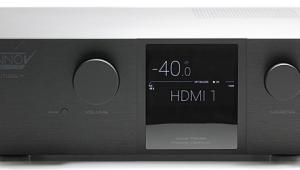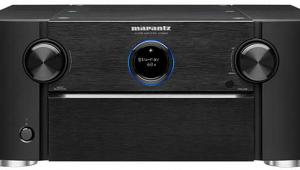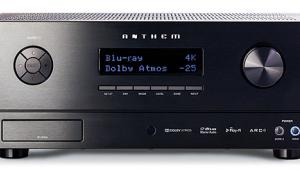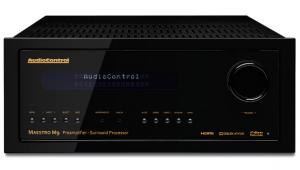Lexicon MC-12 Preamp/Processor
The rumors about Lexicon's new pre/pro have been swirling about for what seems like an eternity. It can do this. It will have that. It may pour you a straight bourbon if you set it up properly. So, it's with no small amount of anticipation that many await their first glimpse of this new megaprocessor, which has been touted (by the grapevine more than Lexicon) as having all of the performance of the highly respected MC-1 with a few more tricks up its sleeve. While the MC-12's goal is certainly to supplant the MC-1 at the top of the Lexicon line, it's undoubtedly aware of the debt of gratitude it owes its predecessor and ancestors like the DC-1, which laid the foundation for the respect and subsequent anticipation that this model enjoyed long before it ever hit the shelves.

Most everyone seems to have some measure of respect for the MC-1 (see Mike Wood's review in the March 2000 issue). For some people, though, there's always a "but." "I love the MC-1, but it doesn't have 5.1-channel inputs…but it processes everything digitally…but it doesn't have component video or balanced outputs…but it looks so weird." You get the idea. All A/V products face this phenomenon, and you may want to keep in mind that the MC-1 is now roughly four years old. Times have changed. If the MC-12 is any indication, Lexicon (unlike some high-end pre/pro makers) is keeping up quite nicely. Just about every complaint people had about the MC-1, no matter how unrealistic, has been addressed on the MC-12—making it the most well-rounded, fully featured, accommodating pre/pro I've come across yet.
It all starts with processing, of course, and the MC-12 does just about everything that can be done at this point: Dolby Digital, EX, and Pro Logic II; DTS and DTS ES (both the matrixed and discrete variations); THX; and Lexicon's proprietary, highly regarded Logic 7 format (with Film, TV, and Music modes), which offers up to seven channels of sound for any source and can be applied to other processing modes, as well. As with the MC-1, each processing mode is highly adjustable and has multiple variations. DTS ES, for example, is available with Logic 7 Film, Logic 7 Music, THX, two-channel, and standard options. You end up getting around 30 different processing options, and none of them is called night club, stadium, or anything of the sort.


By including a two-channel analog bypass and 5.1-channel inputs (which, of course, also serve as an analog bypass), Lexicon has addressed two major MC-1 issues. Both of these features are currently in high demand, predominantly because of the relatively recent emergence of the SACD and DVD-Audio formats. Considering how new these formats are, it's easy to see why the 5.1 inputs were left off the MC-1 four years ago, but those of us who still feel the occasional itch for vinyl wouldn't have minded the two-channel bypass back then. You can apply the two-channel bypass to any of the analog input pairs via the advanced-settings menu. Both it and the 5.1-channel bypass are true throughput modes that forego all conversion, equalization, processing, and crossover. Turning off the bypass lets you access the MC-12's processing through the analog inputs, which is especially important for the 5.1-channel inputs. Many SACD and DVD-Audio players still don't offer bass management; however, unlike many pre/pros and receivers, the MC-12 will supply this when the bypass is defeated.
The MC-12 has plenty of inputs and outputs for each of its three zones: main, zone 2, and record (or a third output zone). There are 12 digital audio inputs, including six coaxial, five optical, and an AES/EBU jack, as well as eight analog audio inputs, which you can configure as eight regular inputs or five inputs plus the 5.1-channel input. As for video inputs, there are five composite, eight S-video, and four high-bandwidth component video, including one with BNC connections. Oddly, the single component output also uses BNC connections. Both the main and record zones offer two composite and two S-video outputs. Zone 2 is strictly audio, with both a fixed and variable analog output. Record/zone 3 also offers the fixed and variable analog outputs, plus optical and coaxial digital outputs. There's a whopping 12 main audio outputs, including front, side, rear, and auxiliary pairs, a center-channel output, and three subwoofer outputs (including a dedicated LFE channel). The MC-12 Balanced model (which costs an additional $1,000) adds balanced (XLR) output to the above and a balanced-output pair for zone 2. Rounding out the array are two RS-232 jacks, four microphone inputs, an IR input, trigger outputs, and an expansion slot that looks like it could eventually hold a DB-25 input.
I can only scratch the surface of the MC-12's capabilities in four pages, so I'll point out a few items that grabbed my attention. Four Analog Devices SHARC 32-bit DSP engines and a Cirrus Logic Crystal CS49326 DSP handle the processing; using the three expansion slots, you can more than quadruple the unit's processing capabilities. Each main audio output employs 24-bit/192-kilohertz digital-to-analog conversion operating in a dual-differential mode. I particularly like the ability to adjust the crossover points on all of the channels. Rather than simply selecting a large or small setting for the front, side, and rear speakers, each crossover is selectable in 10-hertz steps from 30 to 120 Hz, or you can select full-range. There's even a regular 80-Hz option, which engages a 24-decibel/octave filter (as do all the other values), and a THX 80-Hz option, which engages a 12-dB/octave high-pass filter. It's hard to find a stone left unturned on this pre/pro. A minor but entertaining and unique feature is the custom-versus-preset option that allows you to A/B-test your custom settings against the MC-12's factory defaults with the press of a button. Looks like it's time for us settings jockeys to put up or shut up.
For my review of the unbalanced MC-12 unit, I broke out the big guns. The Revel Performa speaker system was already in place (see my review in this issue) and begging for a listen off the Lexicon. Power was supplied by a couple of tasty Levinson No. 436 monoblocks up front, with either the B&K Reference 7270 or my venerable old Krell KAV-500 in the rear. My main source was the crystal-clear Meridian 596 DVD player, although I also used the Sony SCD-CE775 SACD player. Despite this unit's sophistication, setup was relatively quick and painless. What isn't intuitive through the well-executed onscreen menus is easily uncovered in the well-executed manual.
- Log in or register to post comments


























































